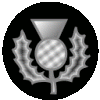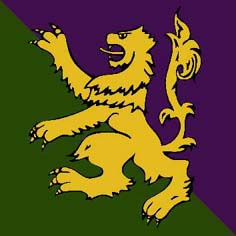
The 9th (Scottish) Division, was an infantry division of the British Army during the First World War, one of the Kitchener's Army divisions raised from volunteers by Lord Kitchener to serve on the Western Front during the First World War.

The 52nd Lowland Volunteers is a battalion in the British Army's Army Reserve or reserve force in the Scottish Lowlands, forming the 6th Battalion of the Royal Regiment of Scotland, also known as 6 SCOTS. Due to its erstwhile association with the 1st Regiment of Foot, it is the senior Reserve line infantry battalion in the British Army. It is one of two Reserve battalions in the Royal Regiment of Scotland, along with 51st Highland, a similar unit located in the Scottish Highlands.

A Scottish regiment is any regiment that at some time in its history has or had a name that referred to Scotland or some part thereof, and adopted items of Scottish dress. These regiments were created after the Acts of Union in 1707 between England and Scotland, either directly serving Britain during its various wars, or as part of the military establishments of Commonwealth countries. Their "Scottishness" is no longer necessarily due to recruitment in Scotland nor any proportion of members of Scottish ancestry.

The Glasgow Highlanders was a former infantry regiment of the British Army, part of the Territorial Force, later renamed the Territorial Army. The regiment eventually became a Volunteer Battalion of the Highland Light Infantry in 1881. The regiment saw active service in both World War I and World War II. In 1959 the Highland Light Infantry was amalgamated with the Royal Scots Fusiliers to form the Royal Highland Fusiliers. The Glasgow Highlanders was later amalgamated into the 52nd Lowland Volunteers in 1967.
The Queen's Edinburgh Rifles was a brigade of Rifle Volunteers raised in the City of Edinburgh in 1859. It later formed two battalions of the Royal Scots, which fought in World War I at Gallipoli, in Palestine and on the Western Front. The two battalions combined between the world wars before being converted into an air defence regiment of the Royal Artillery (RA). This served in Anti-Aircraft Command during World War II and continued in the postwar Territorial Army (TA) until 1961, when its successors were converted into Royal Engineers (RE).

51st Infantry Brigade and Headquarters Scotland is an Adaptable Force Brigade of the British Army. It is the regional administrative formation responsible for all the units of the Army Reserve based in Scotland and an Adaptable Force Brigade under Army 2020. The Brigade is also regionally aligned with the Persian Gulf region as part of defence engagement.
227th Brigade was an infantry formation of the British Army formed for Home Service under various short-lived titles in the First and the Second World Wars. Later it was upgraded to a field formation composed of Scottish troops, and saw heavy fighting in the Normandy and North West Europe Campaign.
The 156th Brigade was an infantry brigade formation of the British Army. The brigade saw active service in both the First and the Second World Wars with the 52nd (Lowland) Infantry Division.
The 155th Brigade was an infantry brigade of the British Army that saw active service in both the First and the Second World Wars. Assigned to the 52nd (Lowland) Division, the brigade saw active service in the Middle East and on the Western Front during the First World War. During the Second World War, now the 155th Infantry Brigade, it continued to serve with the 52nd Division in Operation Dynamo, and later in North-western Europe from late 1944 until May 1945.
The 157th Brigade was an infantry brigade of the British Army. The brigade fought in both the First and the Second World Wars, assigned to 52nd (Lowland) Infantry Division.
The 222nd Infantry Brigade was a Home Service formation of the British Army that existed under various short-lived titles in both the First and Second World Wars

The 223rd Brigade was a Home Defence formation of the British Army in the First and the Second World Wars. It existed under several variations of the 223 Brigade title, and was eventually converted into an airborne formation.
The 224th Brigade was a Home Defence formation of the British Army in World War I and World War II. It existed under several variations of the 224th Brigade title.
71st Division was a short-lived infantry division of the British Army during the First World War. It served in the Home Defence forces and never went overseas.
72nd Division was a short-lived infantry division of the British Army during World War I. It served in the Home Defence forces and never went overseas.
The 195th Brigade was an infantry brigade of the British Army raised during the Great War. The brigade was part of the Territorial Force and created as a 2nd Line of the 156th Brigade and part of the 65th Division, itself formed as a 2nd Line of the 52nd (Lowland) Division. The brigade was initially composed of four battalions of the Cameronians.
The Black Watch Brigade was a Territorial Force infantry brigade of the British Army. Formed in 1908, it was not part of any division, instead being assigned to Coastal Defence duties in Scottish Command. It was dissolved in early 1915 as its constituent battalions were posted to other formations.
The Glasgow Brigade was an infantry formation of Britain's Volunteer Force from 1890 to 1902. It was the forerunner of two formations of the Territorial Force that saw service in both World Wars.
The 6th Battalion, Royal Scots, was a unit of Britain's part-time Territorial Force. Beginning as a Volunteer unit formed from teetotallers in the city of Edinburgh in 1867, it later became affiliated to the Royal Scots. During World War I it served in the Senussi Campaign and on the Western Front. Postwar it was converted into a medium artillery battery.





